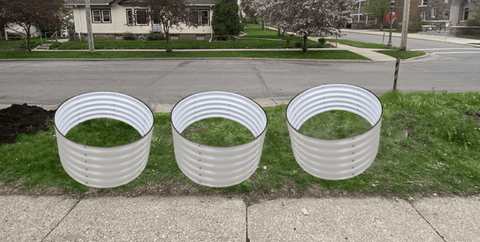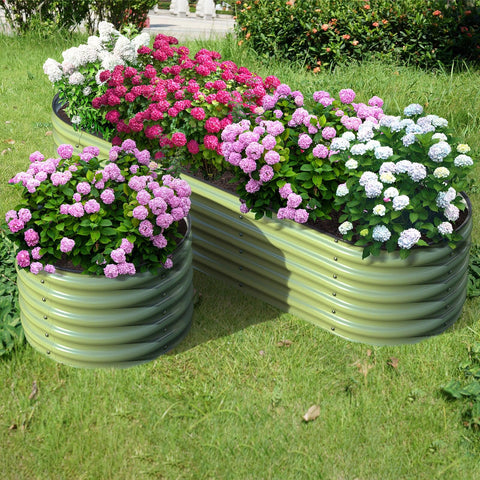5 Reasons You Should Lining Raised Garden Bed
Having a raised garden bed is a good way to grow your favorite flowers and vegetables without bending or pulling your back. Adding your own soil and conditioner has an additional benefit to ensure that your plants thrive in this environment. However, did you know that raised garden beds are vulnerable to many outdoor threats? Fortunately, just add padding to the outdoor raised garden beds to help protect your plants.

Benefits of Lined Garden Beds
Reason 1: keep pests out
Are there burrowing rodents in your backyard? You may need to make sure that there is a liner at the bottom of the raised garden bed to prevent them from entering. If the raised garden bed is placed on the soil or grass without obstacles, common digging pests (such as mole and gopher) can easily enter it. They can easily destroy your plants by destroying their roots or even consuming your green plants. A piece of plastic or tarpaulin may not be enough to keep these excavators away from your raised garden bed. Heavier options, such as hardware cloth, should prevent these pests from invading your garden.
Cause 2: Prevent temperature change
Padding a raised garden bed is essential to prevent temperature fluctuations. The soil in the raised garden bed loses or gains heat faster than the soil in the ground. Padding on raised garden beds provides cushioning or insulation to protect the soil from rapid changes in temperature.
In addition to adding padding to the garden bed to prevent extreme temperature changes, you may also need to consider adding greenhouse bells to plants to protect them from the threat of lower temperatures. This is critical in early spring or autumn, as frost can damage or destroy plants overnight.
Cause 3: weed prevention
Many gardeners will agree that weeding the garden is an ongoing task throughout the growing season. Placing mats on your raised garden bed can prevent these irritating intruders from growing and kill your plants by acting as a physical barrier. By reducing the continuous weeding of raised garden beds throughout the spring and summer, the initial work of installing pads is certainly worth it.
Cause 4: Soil conservation
One advantage of the raised garden bed is to provide special soil for certain plants so that they can thrive. However, if your garden bed is not properly lined, you may lose the beneficial nutrients of this soil and plants due to rain and regular watering. The lining can help water flow and discharge without losing the beneficial materials and nutrients of professional soil.
Cause 5: Protect outdoor surfaces
If you plan to place the raised garden bed on the deck or terrace, you will definitely want a barrier at the bottom. The floors of these outdoor spaces can be made of non porous materials that are easily soiled. Since you may or may not want to keep the raised garden bed in these locations, you need to prevent any staining or discoloration due to any soil or chemicals used to care for the plants.

What material should I use to line my garden bed?
Material 1: landscape fabric
Landscape fabric is an ideal choice to prevent weed growth and reduce soil erosion. Many landscape fabrics are designed to allow water and air to flow through, but prevent weeds from growing through the fabric. The excellent ventilation provided by landscape fabrics can help plants thrive.
Material 2: newspaper or cardboard
If you are looking for an environmentally friendly and inexpensive option to line your raised garden bed, try some old uncoated newspapers or cardboard. These options can still serve as barriers against unwanted weeds and provide insulation. However, these materials can also allow deep-rooted plants to continue to grow and extend underground. Paperboard and newspapers are also excellent sources of nutrition because they are considered "brown" or carbon based substances that will decompose over time.
Material 3: untreated wood
If you are planting herbs and vegetables that you plan to eat, you will certainly ensure that you do not use treated wood. This type of material may contain toxic chemicals that can seep into the soil and into the plants you eat. Avoid the use of additional chemicals in raised garden beds by selecting untreated wood. Some types of untreated wood can also provide additional benefits. For example, untreated cedar is naturally resistant to insects and decay, making it a relatively low maintenance option.
Material 4: metal cloth or wire mesh
Lining the bottom of the raised garden bed with metal cloth or wire mesh is helpful to prevent pests such as hamsters and moles from digging into your garden. The mesh structure also allows water to drain while preventing the entry of pests. If you plan to use these for vegetable, fruit or vanilla gardens, please avoid using materials that may not have food safety coatings to prevent any toxins from seeping into the soil.
Material 5: plastic or waterproof cloth
Many people use plastic sheets or tarpaulins as linings to add protection and insulation to raised garden beds. One disadvantage of plastic is that if it is used at the bottom of the flower bed, it may not allow the water to drain properly. This may lead to problems such as water accumulation and accumulation, root rot, etc. It is best to use plastic as a lining on the inside of the raised garden bed, but use more permeable materials at the bottom, such as landscape fabric or wire mesh.

But remember, if you plant herbs or gardens, you want to know the specific type of plastic you are using. If you do plan to use the tarpaulin in your food garden, make sure it is made of food grade materials, so you don't have to worry about any toxins seeping into the soil or green plants.
